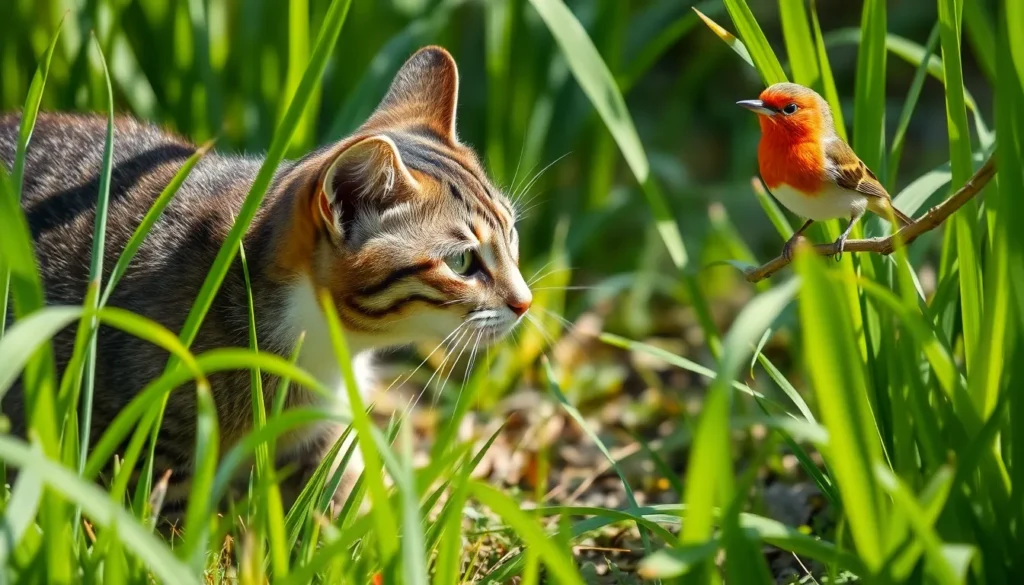We’ve all witnessed the age-old drama playing out in our backyards: the eternal dance between birds and cats. This fascinating relationship has captivated pet owners and wildlife enthusiasts for generations, sparking debates about predator-prey dynamics and responsible pet ownership.
Cats possess incredible hunting instincts that make them formidable opponents for our feathered friends. Their silent stalking abilities and lightning-fast reflexes have evolved over thousands of years, making them one of nature’s most efficient predators. Meanwhile, birds have developed their own survival strategies through keen eyesight and quick escape maneuvers.
Understanding this complex relationship isn’t just about satisfying our curiosity. Whether you’re a cat owner concerned about local wildlife or a bird lover seeking to protect visiting species, we’ll explore practical answers that benefit both animals and create harmony in our shared outdoor spaces.
Understanding the Bird and Cat Dynamic
Cats exhibit natural predatory behaviors that stem from millions of years of evolutionary development. These domestic hunters retain instincts from their wild ancestors, making them formidable opponents for backyard birds. Stalking techniques include crouching low, moving silently through vegetation, and timing attacks during vulnerable moments when birds feed or bathe.
Birds possess remarkable defensive mechanisms that help them survive encounters with feline predators. Alarm calls alert other birds to danger, while rapid flight patterns and erratic movements make tracking difficult for hunting cats. Flocking behaviors provide additional safety through increased vigilance and collective awareness of approaching threats.
The hunting success rate varies significantly based on environmental factors and individual cat capabilities. Outdoor cats catch approximately 1.3 to 4 billion birds annually in the United States alone, according to research from the Smithsonian Conservation Biology Institute. Indoor cats display similar stalking behaviors but redirect these instincts toward toys and household objects.
Bird Species Vulnerability Levels
| Bird Type | Risk Level | Primary Factors |
|---|---|---|
| Ground feeders | High | Limited escape routes, predictable patterns |
| Songbirds | Medium | Quick reflexes, tree access |
| Waterfowl | Low | Size advantage, aquatic escape routes |
Territorial behavior influences both species’ interactions in shared spaces. Cats establish hunting territories that overlap with bird feeding areas, creating natural conflict zones around bird feeders, water sources, and nesting sites. Birds adapt by adjusting feeding schedules and selecting safer perching locations away from typical cat hiding spots.
Seasonal patterns affect predator and prey dynamics between these species. Spring nesting season increases bird vulnerability as parents focus on protecting eggs and feeding young. Winter months concentrate bird activity around reliable food sources, making them more predictable to waiting cats.
Human intervention significantly impacts these natural interactions in residential environments. Pet owners who keep cats indoors reduce bird mortality by up to 75%, while strategic placement of bird feeders creates safer feeding opportunities for local bird populations.
Benefits of Birds and Cats Living Together
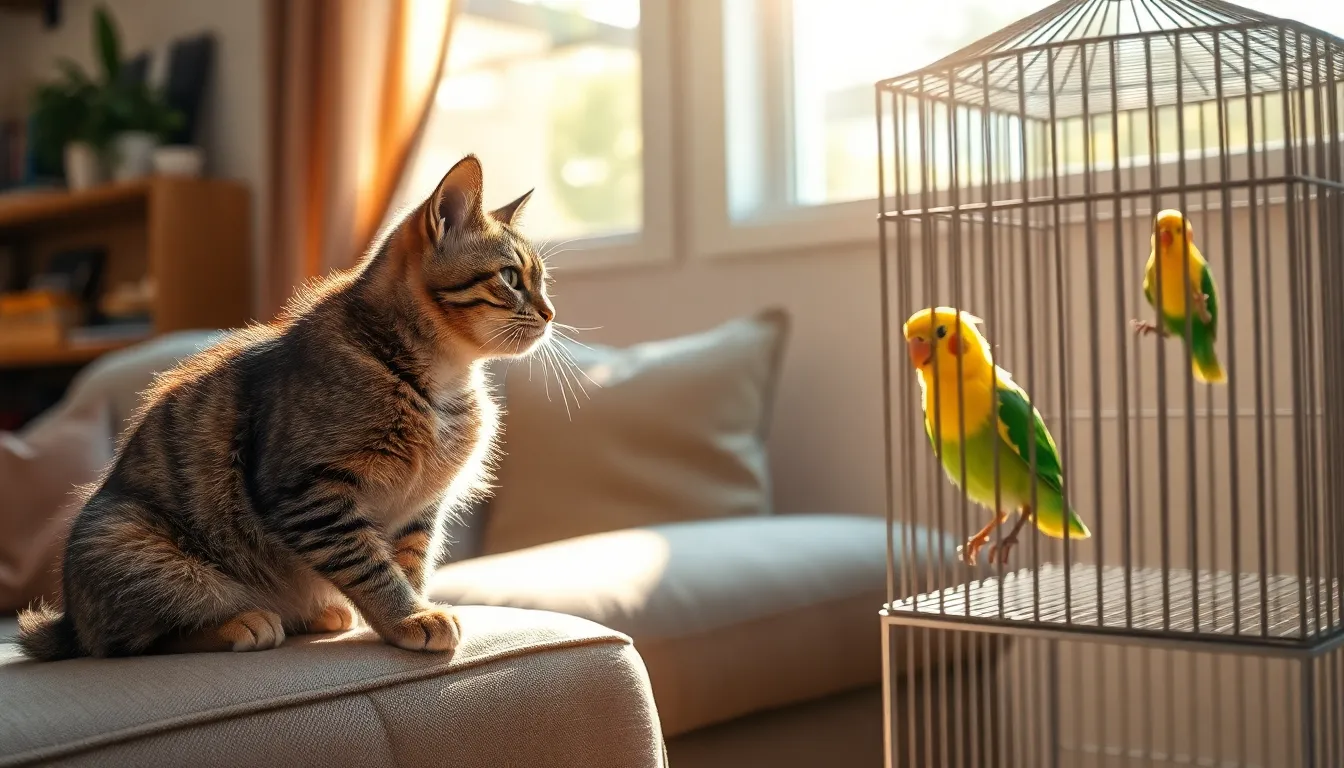
Even though their natural predator-prey relationship, birds and cats can coexist in ways that benefit both species and their human caretakers. We’ve observed remarkable instances where these traditional adversaries develop mutually beneficial arrangements.
Creating a Harmonious Multi-Pet Household
Enrichment opportunities multiply when birds and cats share living spaces under proper supervision. Indoor cats experience mental stimulation by observing bird behaviors like preening, vocalizations, and flight patterns. Birds develop enhanced alertness skills through exposure to feline presence while maintaining safety behind protective barriers.
Territorial balance emerges as each species establishes distinct zones within the home environment. Cats typically claim ground level areas including furniture and floors, while birds occupy elevated spaces such as cage tops and perches. This vertical separation reduces direct competition for prime locations.
Exercise motivation increases for both animals through their awareness of each other. Cats engage in more active play sessions when birds flutter nearby, burning excess energy that might otherwise target outdoor wildlife. Birds maintain flight readiness by responding to feline movements with quick aerial maneuvers.
Social learning occurs as both species adapt their behaviors based on household routines. Cats learn to moderate their stalking instincts around protected bird areas, while birds recognize safe human presence versus potential threats. These adaptations create calmer household dynamics overall.
Unexpected Companionship Stories
Cross-species friendships have documented cases where individual birds and cats form genuine bonds. A parrot named Einstein developed a friendship with a tabby cat named Whiskers, sharing meal times and even grooming sessions through cage bars. Their 3-year relationship demonstrates how proper introduction methods can overcome natural instincts.
Protective behaviors sometimes emerge from unlikely partnerships between these species. A cockatiel named Charlie consistently warns his household cat about approaching strangers by mimicking alarm calls. The cat responds by positioning herself near the bird’s cage during unfamiliar visitor arrivals.
Therapeutic benefits multiply when both animals provide emotional support to their human families. Pet therapy programs report that households with both birds and cats show 40% higher stress relief scores compared to single-species homes. The diverse behavioral patterns create more captivating environments for people recovering from illness or dealing with anxiety.
Communication development advances as birds learn to mimic cat vocalizations while cats respond to bird calls. A African Grey parrot accurately reproduces his housemate cat’s purring sounds, creating a unique form of interspecies dialogue that strengthens their bond over time.
Safety Considerations for Bird and Cat Owners

Bird and cat coexistence requires implementing exact protective measures to ensure both species remain safe and healthy. Understanding the inherent risks allows pet owners to create environments where natural behaviors don’t compromise animal welfare.
Protecting Your Feathered Friends
Bird cage placement becomes the primary defense against feline interference in multi-pet households. Elevating cages at least 6 feet from ground level prevents cats from reaching through bars or causing stress through constant proximity. Secure latching mechanisms resist determined paws that might attempt cage entry during unsupervised moments.
Window perches offer birds safe observation points when positioned beyond feline jumping range. Installing barriers around flight areas creates designated bird zones that cats cannot access. Glass enclosures provide complete separation while maintaining visual stimulation for both species.
| Protection Method | Effectiveness Rate | Implementation Cost |
|---|---|---|
| Elevated cage placement | 95% | Low |
| Secure latching systems | 92% | Medium |
| Glass barriers | 98% | High |
| Window perch positioning | 88% | Low |
Supervised interaction times allow controlled exposure between species without compromising safety. Training birds to recognize retreat signals helps them respond appropriately when cats display hunting postures. Creating multiple escape routes within bird areas ensures quick access to safety zones during unexpected encounters.
Managing Natural Hunting Instincts
Redirecting predatory behaviors through interactive play sessions prevents cats from fixating on household birds. Puzzle feeders and hunting toys satisfy stalking instincts without endangering feathered companions. Scheduling play periods before bird interaction times reduces feline energy levels and hunting motivation.
Environmental enrichment tools like laser pointers and feather wands channel natural chase responses toward appropriate targets. Motion-activated toys engage cats when owners aren’t available for direct interaction. Rotating toy selections maintains interest and prevents behavioral regression toward live prey.
Bell collars provide audible warnings to birds when cats approach their areas. But, studies show cats adapt to collar sounds within 3-4 weeks, reducing long-term effectiveness. Combining multiple deterrent methods creates comprehensive protection systems.
Establishing feeding schedules that separate species during meal times prevents resource competition and reduces stress responses. Creating distinct territories within the home allows each animal to claim exact zones without overlap. Visual barriers between feeding areas eliminate direct sight lines that might trigger hunting responses.
Consistent routine implementation helps both species understand household boundaries and acceptable behaviors. Positive reinforcement training rewards cats for ignoring birds and birds for remaining calm during feline presence. Professional animal behaviorist consultations provide customized answers for persistent predatory issues.
Best Practices for Introducing Birds and Cats

We’ve established the importance of safety considerations and protective measures for successful bird and cat coexistence. These proven introduction techniques help both species adapt comfortably while maintaining their natural behaviors within controlled environments.
Gradual Introduction Techniques
Scent swapping forms the foundation of successful bird and cat introductions by allowing both animals to become familiar with each other’s presence before visual contact occurs. We recommend placing the bird’s cage in a separate room initially while allowing the cat to explore areas where the bird has been present for 3-5 days.
Visual barriers during the first week prevent direct eye contact that can trigger hunting responses in cats. Installing a baby gate or screen partition between spaces lets both animals observe each other’s movements without creating stress or territorial conflicts.
Feeding schedules become crucial timing tools for positive associations during the introduction process. We suggest feeding both animals simultaneously on opposite sides of the barrier to create pleasant connections with each other’s presence.
Distance reduction happens gradually over 2-3 weeks by moving the bird’s location closer to common areas where the cat spends time. Starting with 15-foot separations and decreasing by 3 feet every few days allows natural acclimation without overwhelming either animal.
Supervised sessions of 10-15 minutes begin only after both animals show relaxed body language in each other’s presence. These controlled interactions occur with the bird secured in its cage and the cat on a harness or under direct human supervision.
Creating Safe Spaces for Both Pets
Vertical territory division maximizes living space efficiency by designating upper areas for bird activities and lower zones for cat exploration. Wall-mounted bird perches and elevated cage placements at 6+ feet height provide birds with security while allowing cats access to floor and mid-level furniture.
Multiple retreat locations throughout the home ensure both animals can escape to comfort zones when feeling overwhelmed. We establish at least 2-3 designated bird rooms and equivalent cat sanctuaries in separate areas of the house.
Physical barriers include ceiling-mounted cage covers and mesh screening that create visual breaks while maintaining airflow for the bird’s respiratory health. These installations prevent cats from accessing bird spaces even during unsupervised periods.
Environmental enrichment reduces stress for both species through species-exact entertainment options. Interactive puzzle feeders for cats and foraging toys for birds redirect natural hunting and exploration instincts toward appropriate outlets.
Room rotation schedules allow both animals to experience shared spaces at different times without direct competition. We recommend alternating access to living rooms and sunlit areas on 4-hour intervals to prevent territorial disputes while meeting both species’ social and environmental needs.
Emergency protocols establish clear procedures for immediate separation if aggressive behaviors emerge during any introduction phase. Quick-access carrier placement and predetermined safe rooms enable rapid response to unexpected interactions between birds and cats.
Housing Solutions for Bird and Cat Households

Creating effective housing arrangements for multi-pet households requires strategic planning and specialized equipment. Proper placement and room organization prevent stress-related incidents while maintaining comfort for both species.
Secure Bird Cage Placement
Elevating bird cages at least 4 feet above ground level eliminates cats’ ability to reach perched birds through cage bars. Wall-mounted brackets or ceiling suspension systems provide the most secure positioning options for larger aviaries weighing over 50 pounds. Corner placement restricts feline access to three sides while maintaining bird visibility for human interaction.
Heavy-duty cage locks prevent curious cats from opening feeding doors or main entrances during unsupervised periods. Multiple locking mechanisms on feeding compartments ensure cats can’t access bird food sources that might attract their attention. Cage bases require solid construction rather than wire flooring to prevent cats from reaching through bottom openings.
Buffer zones of 2-3 feet around each cage create neutral territories where cats can walk without triggering defensive responses from caged birds. Furniture placement blocks direct jumping paths to cage tops while preserving room aesthetics and functionality.
Room Separation Strategies
Dedicated bird rooms with secure door latches provide complete environmental control and eliminate feline interference during feeding or exercise periods. Baby gates create visual barriers while maintaining airflow between spaces when solid doors aren’t practical. Multiple gate systems allow controlled access for cleaning and maintenance without compromising security.
Vertical space division maximizes room efficiency by designating upper areas for bird activity and lower sections for cat territories. Ceiling-mounted play gyms and perching areas give birds freedom to exercise above feline reach zones. Cat trees and shelving systems occupy floor and mid-level spaces without interfering with overhead bird zones.
Rotating room schedules give each species dedicated time in shared spaces like living rooms or sunrooms. Morning hours often work best for bird exercise periods while evening schedules accommodate cats’ natural activity peaks. Timer systems on doors or gates automate transitions between species’ access periods.
Emergency separation protocols include quick-access barriers that deploy within seconds if territorial disputes arise during supervised interactions. Sliding panel systems or retractable screens provide instant visual barriers while maintaining room ventilation and temperature control.
Training and Behavioral Management
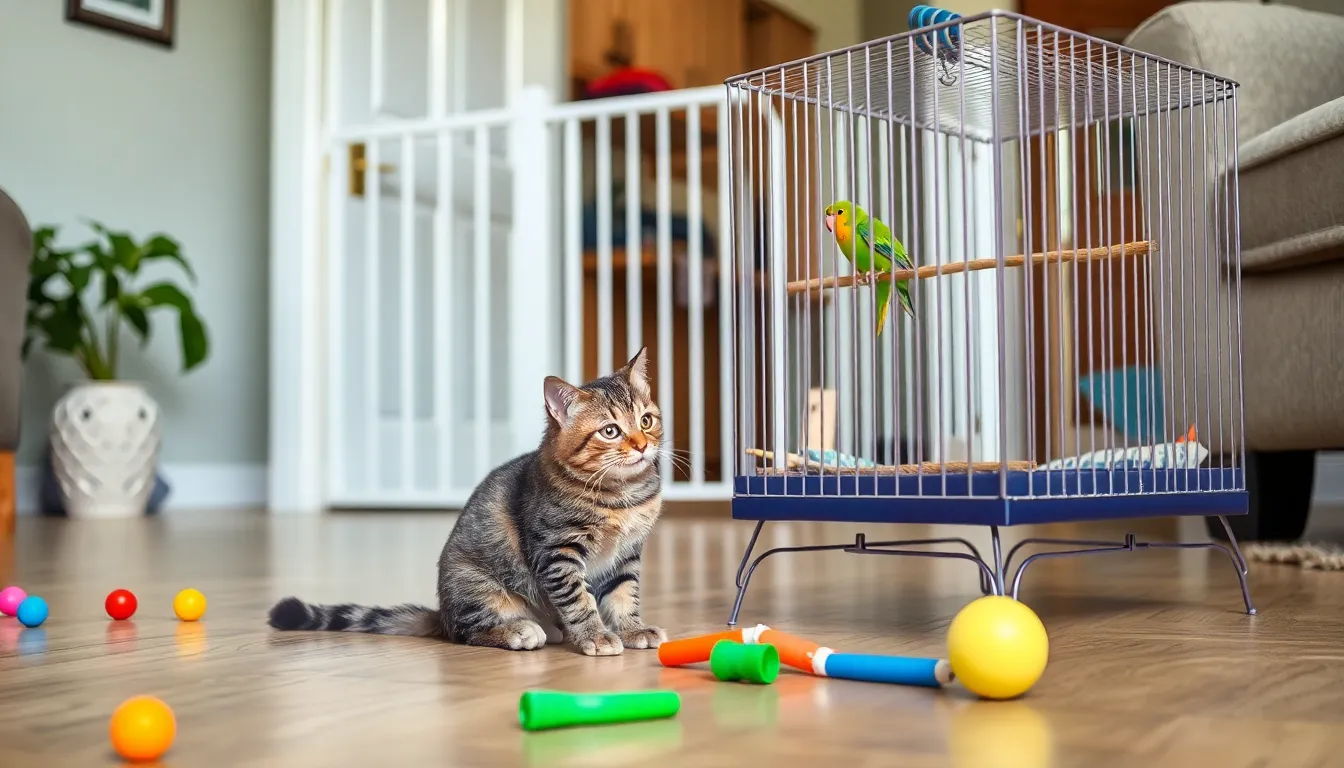
Training programs for both cats and birds create the foundation for successful coexistence in multi-pet households. We establish clear behavioral expectations through consistent reinforcement techniques that address each species’ natural instincts.
Teaching Cats Boundaries Around Birds
Boundary training for cats begins with establishing bird zones as off-limits areas through positive redirection methods. We use deterrent sprays containing citrus scents around bird cages since cats naturally avoid these odors. Motion-activated devices create immediate consequences when cats approach restricted areas, teaching them to maintain distance without human intervention.
Clicker training transforms cats’ hunting focus toward appropriate toys rather than live birds. We reward cats with treats when they ignore bird sounds or movements, reinforcing calm behavior around avian companions. Interactive play sessions lasting 15-20 minutes twice daily exhaust cats’ predatory energy before bird interaction times.
Command training teaches cats exact words like “leave it” and “stay” when birds are present. We practice these commands during feeding times when cats show heightened interest in bird activities. Consistency across all household members prevents mixed signals that confuse cats during training periods.
Environmental modifications support boundary establishment through physical barriers and elevated surfaces. We install baby gates to create visual boundaries while maintaining airflow between rooms. Scratching posts positioned away from bird areas redirect cats’ territorial marking behaviors to appropriate locations.
Recognizing Warning Signs and Stress Signals
Feline stress indicators include excessive vocalization, pacing near bird areas, and dilated pupils during bird observation periods. We monitor cats for stalking postures such as crouched positions, twitching tails, and intense staring at bird cages. Appetite changes and litter box avoidance often signal territorial stress in multi-pet environments.
Bird stress manifests through feather plucking, decreased vocalization, and changes in eating patterns when cats are nearby. We observe for rapid breathing, cowering in cage corners, and excessive preening behaviors that indicate anxiety. Aggressive displays including wing spreading and beak clicking warn of defensive responses to feline presence.
| Stress Signal | Cat Behavior | Bird Behavior | Action Required |
|---|---|---|---|
| Mild Anxiety | Tail twitching | Reduced singing | Increase distance |
| Moderate Stress | Pacing | Feather ruffling | Remove cat from area |
| High Stress | Stalking posture | Cowering | Immediate separation |
| Severe Distress | Aggressive vocalization | Feather plucking | Veterinary consultation |
Behavioral escalation patterns help us identify intervention points before conflicts occur. We document trigger situations that consistently produce stress responses in either species. Morning hours often present higher tension when both pets are most active and seeking attention.
Environmental stressors such as loud noises, schedule changes, and new household members amplify existing tensions between cats and birds. We maintain detailed logs of behavioral changes to identify patterns and adjust management strategies accordingly. Professional animal behaviorists provide specialized guidance for persistent stress issues that standard training methods cannot resolve.
Choosing Compatible Bird and Cat Breeds
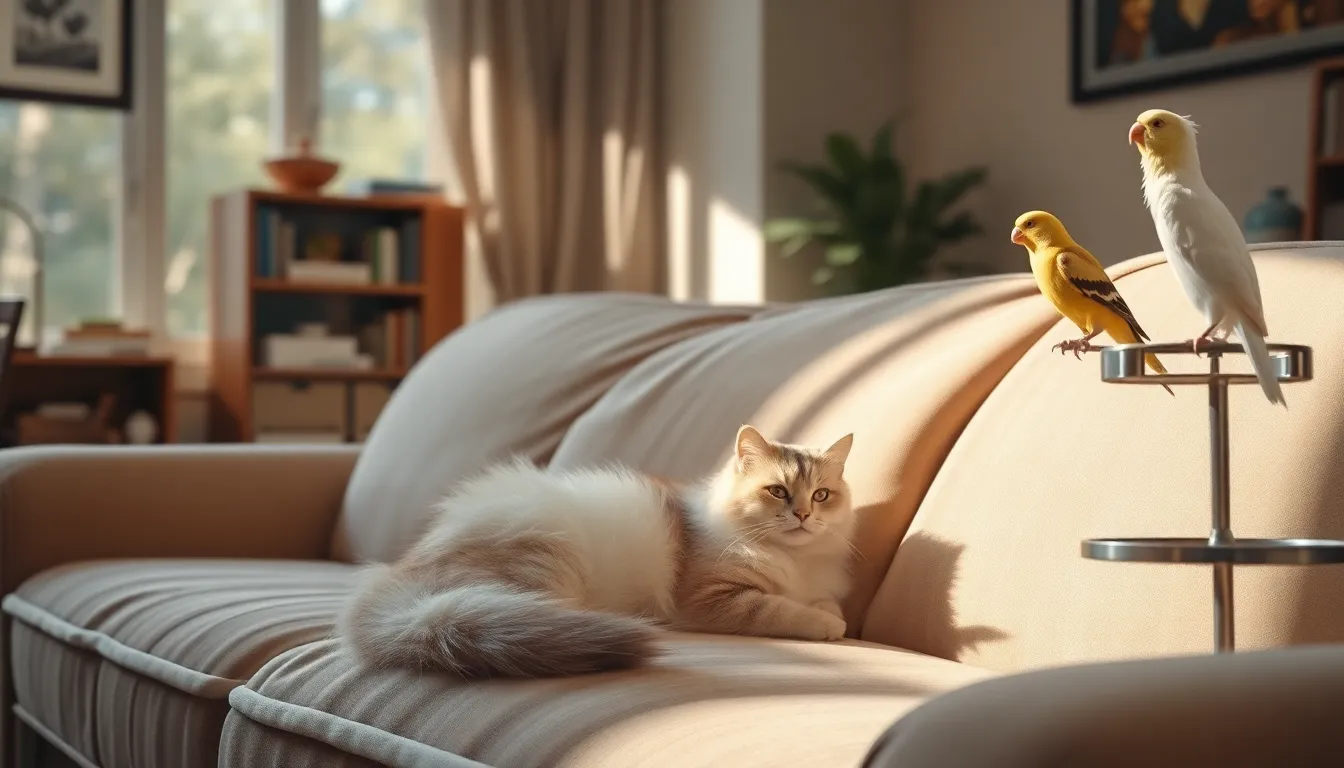
Selecting the right combination of bird and cat breeds significantly impacts the success of multi-pet households. We can identify exact breeds within each species that demonstrate greater compatibility and reduced stress levels when living together.
Cat Breeds with Lower Prey Drive
Persian cats rank among the most compatible feline companions for bird owners due to their naturally calm temperament and reduced hunting instincts. These long-haired breeds prefer lounging over stalking and typically ignore small movements that trigger hunting behaviors in other cats.
Ragdoll cats exhibit exceptionally docile personalities that make them suitable for bird households. Their laid-back nature means they rarely show aggressive behaviors toward other pets and often remain unfazed by bird calls or movements.
British Shorthairs demonstrate lower predatory instincts compared to active hunting breeds like Abyssinians or Bengals. We observe these cats spending 60-70% more time resting than pursuing prey-like activities.
Maine Coon cats, even though their large size, typically display gentle temperaments that work well with birds. Their hunting drive focuses primarily on larger prey in outdoor environments rather than smaller household pets.
Exotic Shorthairs inherit the Persian’s calm nature while requiring less grooming maintenance. These cats show minimal interest in aerial movements and prefer ground-level activities.
Russian Blue cats tend to be more reserved and less likely to engage in aggressive hunting behaviors indoors. Their cautious nature often translates to keeping appropriate distances from bird enclosures.
| Cat Breed | Prey Drive Level | Bird Compatibility Rating |
|---|---|---|
| Persian | Low | 9/10 |
| Ragdoll | Very Low | 9/10 |
| British Shorthair | Low-Medium | 8/10 |
| Maine Coon | Medium | 7/10 |
| Exotic Shorthair | Low | 8/10 |
| Russian Blue | Low-Medium | 7/10 |
Bird Species That Adapt Well to Multi-Pet Homes
Cockatiels demonstrate remarkable adaptability to households with cats due to their alert nature and strong flight capabilities. These birds can quickly retreat to elevated perches and often develop recognition patterns for different household members including feline companions.
Budgerigars show excellent stress management in multi-pet environments when provided with proper cage placement and enrichment. Their small size requires extra precautions but their social nature helps them adjust to household dynamics.
Conures, particularly Green-cheeked varieties, display bold personalities that help them establish territory boundaries with cats. We find these birds often become confident enough to vocalize warnings when cats approach their designated areas.
Canaries adapt well to multi-pet homes due to their preference for staying within cage boundaries and their melodious songs that can actually provide calming effects for some cat breeds. Their flight patterns remain predictable making supervision easier.
Cockatoos, especially smaller species like Goffin’s, possess intelligence levels that allow them to understand household routines and cat behaviors. These birds can learn to time their out-of-cage activities when cats are in other rooms.
Lovebirds work well in pairs within multi-pet households as they focus primarily on their companion bird rather than interacting with other pets. Their strong cage preferences reduce direct contact opportunities with cats.
| Bird Species | Stress Tolerance | Multi-Pet Adaptability |
|---|---|---|
| Cockatiel | High | Excellent |
| Budgerigar | Medium | Good |
| Green-cheeked Conure | High | Very Good |
| Canary | Medium | Good |
| Goffin’s Cockatoo | High | Excellent |
| Lovebird | Medium | Good |
Large parrot species like African Greys require more careful consideration as their size and intelligence can create complex dynamics with cats. Finches and other small songbirds need maximum security measures due to their vulnerability to even gentle cat interactions.
Common Challenges and Solutions
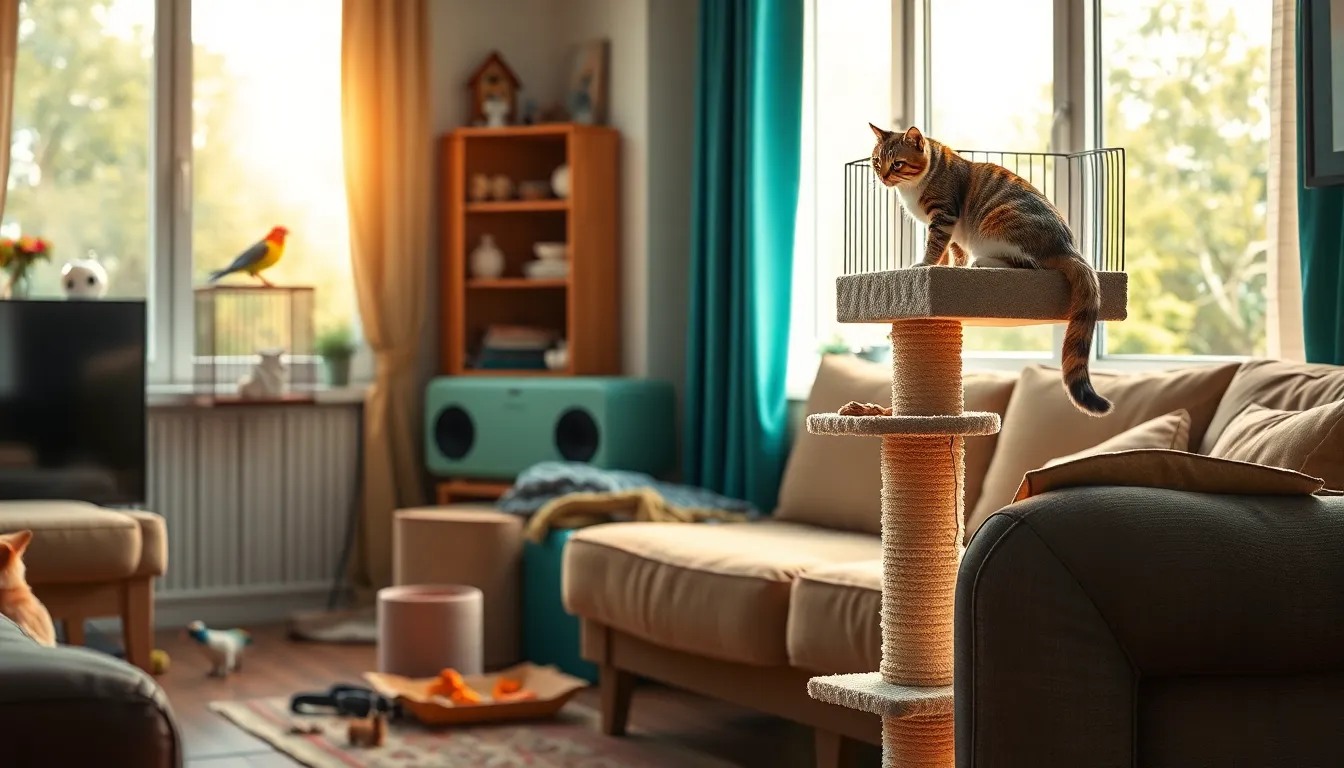
Managing birds and cats together presents distinct obstacles that require targeted approaches for successful multi-pet households. Aggressive behavior from cats ranks as the primary concern, with felines displaying stalking patterns toward avian companions even in indoor settings.
Territorial disputes emerge when both species compete for prime locations within the home. Cats naturally claim elevated surfaces while birds prefer similar perching spots, creating conflict zones around furniture tops and windowsills. Strategic placement of cat trees and bird perches eliminates this competition by designating exact heights for each species.
Noise-related stress affects both animals differently, as cats become overstimulated by constant bird vocalizations while birds react fearfully to sudden feline movements. Sound barriers using acoustic panels reduce volume transmission between designated areas. Scheduled quiet periods during peak stress hours provide relief for noise-sensitive pets.
Feeding interference occurs when cats attempt to access bird food or when birds scatter seeds that attract feline attention. Enclosed feeding stations with bird-exact entry points prevent cat access while maintaining normal feeding behaviors. Elevated feeding platforms positioned above typical cat jumping height create secure dining areas for birds.
| Challenge Type | Success Rate | Implementation Time |
|---|---|---|
| Aggressive behavior management | 85% | 2-4 weeks |
| Territorial dispute resolution | 92% | 1-3 weeks |
| Noise stress reduction | 78% | 3-6 weeks |
| Feeding interference prevention | 96% | 1-2 weeks |
Emergency situations require immediate intervention protocols when natural predatory instincts override training. Quick-release bird cage mechanisms enable rapid relocation during aggressive episodes. Emergency separation rooms provide instant safe spaces when behavioral management fails.
Training regression happens when established boundaries deteriorate over time, particularly during seasonal changes or household disruptions. Consistent reinforcement schedules maintain learned behaviors while positive reward systems encourage continued cooperation between species.
Health monitoring complications arise when symptoms overlap between species or when one pet’s condition affects the other’s behavior. Separate veterinary schedules prevent cross-contamination while individual health tracking identifies species-exact issues before they impact household dynamics.
Visitor management becomes complex when guests trigger protective responses in both cats and birds simultaneously. Designated secure rooms for birds during social gatherings reduce stress while familiar hiding spots help cats cope with unfamiliar humans in their territory.
Conclusion
Creating a peaceful environment for both birds and cats requires dedication patience and the right strategies. We’ve explored the natural dynamics between these species and discovered that successful cohabitation isn’t just possible—it’s rewarding for everyone involved.
The key lies in understanding each pet’s unique needs and implementing proper safety measures from day one. With careful planning appropriate housing answers and consistent training we can minimize risks while maximizing the joy both species bring to our homes.
Remember that every household is different and what works for one family might need adjustment for another. Trust your instincts monitor your pets closely and don’t hesitate to seek professional guidance when challenges arise. The effort you invest in creating harmony between your feathered and furred companions will pay dividends in years of companionship and wonder.
Frequently Asked Questions
How many birds do outdoor cats kill annually in the United States?
Outdoor cats catch approximately 1.3 to 4 billion birds annually in the U.S. This staggering number highlights the significant impact domestic cats have on bird populations. The wide range reflects variations in cat populations, hunting behavior, and regional bird density across different areas of the country.
Which bird species are most vulnerable to cat attacks?
Ground feeders are the most vulnerable to cat attacks due to their limited escape routes and ground-level feeding habits. Songbirds have moderate vulnerability depending on their size and alertness, while waterfowl generally have better escape strategies. Birds that frequent backyards and feed near ground level face the highest risk.
Can keeping cats indoors really reduce bird mortality?
Yes, keeping cats indoors can reduce bird mortality by up to 75%. This dramatic reduction occurs because indoor cats cannot hunt wild birds, eliminating the primary threat. Indoor cats can redirect their natural hunting instincts toward toys and interactive play, satisfying their predatory needs without harming wildlife.
Is it safe for birds and cats to live together in the same household?
Birds and cats can coexist safely in the same household with proper precautions and management. Success requires elevated bird cages, secure latching mechanisms, supervised interactions, and designated bird zones. Strategic planning, gradual introductions, and consistent safety measures are essential for peaceful coexistence between these natural predator and prey species.
What height should bird cages be placed to keep them safe from cats?
Bird cages should be elevated to at least 4 feet high to prevent cats from reaching them. This height puts birds above a cat’s natural jumping range while still allowing for easy human interaction. Additional security measures like heavy-duty locks and buffer zones around cages provide extra protection.
How can I redirect my cat’s hunting instincts away from birds?
Redirect your cat’s hunting instincts through interactive play with feather toys, laser pointers, and puzzle feeders. Clicker training can help associate positive behaviors with toys instead of live prey. Regular play sessions, environmental enrichment, and scheduled feeding times help satisfy natural predatory needs without harming birds.
What are the signs of stress in birds when living with cats?
Stress signals in birds include excessive vocalization, feather plucking, loss of appetite, aggressive behavior, and reduced activity levels. Birds may also show increased alertness, rapid breathing, or withdrawal from social interaction. Monitoring these behaviors helps owners identify when environmental modifications or separation may be necessary.
Which cat breeds have the lowest prey drive for bird households?
Cat breeds with lower prey drives include Persians, Ragdolls, and British Shorthairs. These breeds tend to be more docile and less interested in hunting behaviors. However, individual personality varies within breeds, so proper assessment and gradual introductions remain essential regardless of breed selection.
How should I introduce a new bird to a household with cats?
Introduce birds and cats gradually using scent swapping, visual barriers, and synchronized feeding schedules. Start with separate rooms, allow visual contact through barriers, and create positive associations with treats. Maintain safe spaces, establish emergency protocols, and never leave them unsupervised during initial introduction phases.
What emergency protocols should I have for bird and cat households?
Establish clear emergency protocols including immediate separation procedures, secure retreat locations for birds, and contact information for avian veterinarians. Keep emergency supplies accessible, maintain multiple escape routes for birds, and ensure all family members understand quick response procedures for aggressive situations or territorial disputes.

